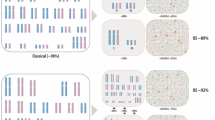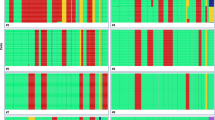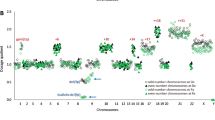Abstract
Although childhood high hyperdiploid acute lymphoblastic leukemia is associated with a favorable outcome, 20% of patients still relapse. It is important to identify these patients already at diagnosis to ensure proper risk stratification. We have investigated 11 paired diagnostic and relapse samples with single nucleotide polymorphism array and mutation analyses of FLT3, KRAS, NRAS and PTPN11 in order to identify changes associated with relapse and to ascertain the genetic evolution patterns. Structural changes, mainly cryptic hemizygous deletions, were significantly more common at relapse (P<0.05). No single aberration was linked to relapse, but four deletions, involving IKZF1, PAX5, CDKN2A/B or AK3, were recurrent. On the basis of the genetic relationship between the paired samples, three groups were delineated: (1) identical genetic changes at diagnosis and relapse (2 of 11 cases), (2) clonal evolution with all changes at diagnosis being present at relapse (2 of 11) and (3) clonal evolution with some changes conserved, lost or gained (7 of 11), suggesting the presence of a preleukemic clone. This ancestral clone was characterized by numerical changes only, with structural changes and RTK-RAS mutations being secondary to the high hyperdiploid pattern.
This is a preview of subscription content, access via your institution
Access options
Subscribe to this journal
Receive 12 print issues and online access
$259.00 per year
only $21.58 per issue
Buy this article
- Purchase on Springer Link
- Instant access to full article PDF
Prices may be subject to local taxes which are calculated during checkout


Similar content being viewed by others
References
Paulsson K, Johansson B . High hyperdiploid childhood acute lymphoblastic leukemia. Genes Chromosomes Cancer 2009; 48: 637–660.
Heerema NA, Sather HN, Sensel MG, Zhang T, Hutchinson RJ, Nachman JB et al. Prognostic impact of trisomies of chromosomes 10, 17, and 5 among children with acute lymphoblastic leukemia and high hyperdiploidy (>50 chromosomes). J Clin Oncol 2000; 18: 1876–1887.
Moorman AV, Richards SM, Martineau M, Luk Cheung K, Robinson HM, Reza Jalali G et al. Outcome heterogeneity in childhood high-hyperdiploid acute lymphoblastic leukemia. Blood 2003; 102: 2756–2762.
Forestier E, Heyman M, Andersen MK, Autio K, Blennow E, Borgström G et al. Outcome of ETV6/RUNX1-positive childhood acute lymphoblastic leukaemia in the NOPHO-ALL-1992 protocol: frequent late relapses but good overall survival. Br J Haematol 2008; 140: 665–672.
Pui C-H, Raimondi SC, Dodge RK, Rivera GK, Fuchs LA, Abromowitch M et al. Prognostic importance of structural chromosomal abnormalities in children with hyperdiploid (>50 chromosomes) acute lymphoblastic leukemia. Blood 1989; 73: 1963–1967.
Raimondi SC, Pui C-H, Hancock ML, Behm FG, Filatov L, Rivera GK . Heterogeneity of hyperdiploid (51–67) childhood acute lymphoblastic leukemia. Leukemia 1996; 10: 213–224.
Forestier E, Johansson B, Gustafsson G, Borgström G, Kerndrup G, Johannsson J et al. Prognostic impact of karyotypic findings in childhood acute lymphoblastic leukaemia: a Nordic series comparing two treatment periods. Br J Haematol 2000; 110: 147–153.
Harris MB, Shuster JJ, Carroll A, Look AT, Borowitz MJ, Crist WM et al. Trisomy of leukemic cell chromosomes 4 and 10 identifies children with B-progenitor cell acute lymphoblastic leukemia with a very low risk of treatment failure: a Pediatric Oncology Group study. Blood 1992; 79: 3316–3324.
Sutcliffe MJ, Shuster JJ, Sather HN, Camitta BM, Pullen J, Schultz KR et al. High concordance from independent studies by the Children's Cancer Group (CCG) and Pediatric Oncology Group (POG) associating favorable prognosis with combined trisomies 4, 10, and 17 in children with NCI standard-risk B-precursor acute lymphoblastic leukemia: a Children's Oncology Group (COG) initiative. Leukemia 2005; 19: 734–740.
Schultz KR, Pullen DJ, Sather HN, Shuster JJ, Devidas M, Borowitz MJ et al. Risk- and response-based classification of childhood B-precursor acute lymphoblastic leukemia: a combined analysis of prognostic markers from the Pediatric Oncology Group (POG) and Children's Cancer Group (CCG). Blood 2007; 109: 926–935.
Yang JJ, Bhojwani D, Yang W, Cai X, Stocco G, Crews K et al. Genome-wide copy number profiling reveals molecular evolution from diagnosis to relapse in childhood acute lymphoblastic leukemia. Blood 2008; 112: 4178–4183.
Mullighan CG, Phillips LA, Su X, Ma J, Miller CB, Shurtleff SA et al. Genomic analysis of the clonal origins of relapsed acute lymphoblastic leukemia. Science 2008; 322: 1377–1380.
Molteni CG, te Kronnie G, Bicciato S, Villa T, Tartaglia M, Basso G et al. PTPN11 mutations in childhood acute lymphoblastic leukemia occur as a secondary event associated with high hyperdiploidy. Leukemia 2010; 24: 232–235.
Paulsson K, Cazier JB, Macdougall F, Stevens J, Stasevich I, Vrcelj N et al. Microdeletions are a general feature of adult and adolescent acute lymphoblastic leukemia: unexpected similarities with pediatric disease. Proc Natl Acad Sci USA 2008; 105: 6708–6713.
Venkatraman ES, Olshen AB . A faster circular binary segmentation algorithm for the analysis of array CGH data. Bioinformatics 2007; 23: 657–663.
Lin M, Wei L-J, Sellers WR, Lieberfarb M, Wong WH, Li C . dChipSNP: significance curve and clustering of SNP-array-based loss-of-heterozygosity data. Bioinformatics 2004; 20: 1233–1240.
Paulsson K, Horvat A, Strömbeck B, Nilsson F, Heldrup J, Behrendtz M et al. Mutations of FLT3, NRAS, KRAS, and PTPN11 are frequent and possibly mutually exclusive in high hyperdiploid childhood acute lymphoblastic leukemia. Genes Chromosomes Cancer 2007; 47: 26–33.
Strefford JC, Worley H, Barber K, Wright S, Stewart ARM, Robinson HM et al. Genome complexity in acute lymphoblastic leukemia is revealed by array-based comparative genomic hybridization. Oncogene 2007; 26: 4306–4318.
Davidsson J, Andersson A, Paulsson K, Heidenblad M, Isaksson M, Borg A et al. Tiling resolution array comparative genomic hybridization, expression and methylation analyses of dup(1q) in Burkitt lymphomas and pediatric high hyperdiploid acute lymphoblastic leukemias reveal clustered near-centromeric breakpoints and overexpression of genes in 1q22-32.3. Hum Mol Genet 2007; 16: 2215–2225.
Paulsson K, Heidenblad M, Mörse H, Borg Å, Fioretos T, Johansson B . Identification of cryptic aberrations and characterization of translocation breakpoints using array CGH in high hyperdiploid childhood acute lymphoblastic leukemia. Leukemia 2006; 20: 2002–2007.
Mullighan CG, Goorha S, Radtke I, Miller CB, Coustan-Smith E, Dalton JD et al. Genome-wide analysis of genetic alterations in acute lymphoblastic leukaemia. Nature 2007; 446: 758–764.
Secker-Walker LM, Alimena G, Bloomfield CD, Kaneko Y, Whang-Peng J, Arthur DC et al. Cytogenetic studies of 21 patients with acute lymphoblastic leukemia in relapse. Cancer Genet Cytogenet 1989; 40: 163–169.
Shikano T, Ishikawa Y, Ohkawa M, Hatayama Y, Nakadate H, Hatae Y et al. Karyotypic changes from initial diagnosis to relapse in childhood acute leukemia. Leukemia 1990; 4: 419–422.
Abshire TC, Buchanan GR, Jackson JF, Shuster JJ, Brock B, Head D et al. Morphologic, immunologic and cytogenetic studies in children with acute lymphoblastic leukemia at diagnosis and relapse: a Pediatric Oncology Group study. Leukemia 1992; 6: 357–362.
Heerema NA, Palmer CG, Weetman R, Bertolone S . Cytogenetic analysis in relapsed childhood acute lymphoblastic leukemia. Leukemia 1992; 6: 185–192.
Vora AJ, Potter AM, Anderson LM, Lilleyman JS . Frequency and importance of change in blast cell karyotype in relapsing childhood lymphoblastic leukemia. Pediatr Hematol Oncol 1994; 11: 379–386.
Chucrallah AE, Stass SA, Huh YO, Albitar M, Kantarjian HM . Adult acute lymphoblastic leukemia at relapse. Cytogenetic, immunophenotypic, and molecular changes. Cancer 1995; 76: 985–991.
Case M, Matheson E, Minto L, Hassan R, Harrison CJ, Bown N et al. Mutation of genes affecting the RAS pathway is common in childhood acute lymphoblastic leukemia. Cancer Res 2008; 68: 6803–6809.
Sulong S, Moorman AV, Irving JAE, Strefford JC, Konn ZJ, Case MC et al. A comprehensive analysis of the CDKN2A gene in childhood acute lymphoblastic leukemia reveals genomic deletion, copy number neutral loss of heterozygosity, and association with specific cytogenetic subgroups. Blood 2009; 113: 100–107.
Den Boer ML, van Slegtenhorst M, De Menezes RX, Cheok MH, Buijs-Gladdines JGCAM, Peters STCM et al. A subtype of childhood acute lymphoblastic leukaemia with poor treatment outcome: a genome-wide classification study. Lancet Oncol 2009; 10: 125–134.
Mullighan CG, Su X, Zhang J, Radtke I, Phillips LA, Miller CB et al. Deletion of IKZF1 and prognosis in acute lymphoblastic leukemia. N Engl J Med 2009; 360: 470–480.
Panzer-Grümayer ER, Fasching K, Panzer S, Hettinger K, Schmitt K, Stöckler-Ipsiroglu S et al. Nondisjunction of chromosomes leading to hyperdiploid childhood B-cell precursor acute lymphoblastic leukemia is an early event during leukemogenesis. Blood 2002; 100: 347–349.
Maia AT, Tussiwand R, Cazzaniga G, Rebulla P, Colman S, Biondi A et al. Identification of preleukemic precursors of hyperdiploid acute lymphoblastic leukemia in cord blood. Genes Chromosomes Cancer 2004; 40: 38–43.
Acknowledgements
This work was supported by grants from the Swedish Childhood Cancer Foundation, the Swedish Cancer Society and the Swedish Research Council.
Author information
Authors and Affiliations
Corresponding author
Ethics declarations
Competing interests
The authors declare no conflict of interest.
Additional information
Data deposition: The microarray data are deposited in the ArrayExpress repository (http://www.ebi.ac.uk/microarray-as/ae/) with the ID E-MEXP-2333.
Rights and permissions
About this article
Cite this article
Davidsson, J., Paulsson, K., Lindgren, D. et al. Relapsed childhood high hyperdiploid acute lymphoblastic leukemia: presence of preleukemic ancestral clones and the secondary nature of microdeletions and RTK-RAS mutations. Leukemia 24, 924–931 (2010). https://doi.org/10.1038/leu.2010.39
Received:
Revised:
Accepted:
Published:
Issue Date:
DOI: https://doi.org/10.1038/leu.2010.39
Keywords
This article is cited by
-
The Eμ-Ret mouse is a novel model of hyperdiploid B-cell acute lymphoblastic leukemia
Leukemia (2024)
-
Spectrum and clinical features of gene mutations in Chinese pediatric acute lymphoblastic leukemia
BMC Pediatrics (2023)
-
Clonal origin and development of high hyperdiploidy in childhood acute lymphoblastic leukaemia
Nature Communications (2023)
-
An alternative CYB5A transcript is expressed in aneuploid ALL and enriched in relapse
BMC Genomic Data (2022)
-
RAS pathway mutations as a predictive biomarker for treatment adaptation in pediatric B-cell precursor acute lymphoblastic leukemia
Leukemia (2018)



